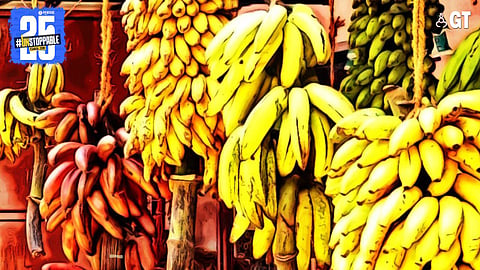

Swaying coconut palms, lining beaches and roads have almost become a trademark sight in Goa. But, apart from these trees, a variety of trees of culinary value are found in Goa, one of them being banana trees.
The large herbaceous plant that we know as the banana tree is actually a bunch of sheathing leaf-bases that form a pseudo-stem below a broad crown of leaves. While the plant is mostly grown for its fruit, the central core of the pseudo-stem can be made into a healthy juice or cooked as food.
The mature outer sheaths can be used to make paper, while the fibre is used to make bags, ropes and even fabric.
BEYOND THE EDIBLE
In Goa, dry banana fibre has traditionally been used for braiding flowers, especially in the form of a venni or fanti (small hair garlands) and also for tying bundles of vegetable seedlings or even vegetables such as radish.
Banana leaves have long been used for wrapping and as disposable plates. And, with the growing awareness of how plastics have damaged the environment, the banana plant is proving to be quite an inspiration for the next generation.
ORIGINS & TECHNICAL INFO
Banana plants are of Indo-Malayan origin, and hence, native to India. Cultivated bananas are autotriploids, and have three sets of chromosomes, just like a mango plant.
Unlike a mango, bananas are generally parthenocarpic and do not produce viable seeds. Obviously, there are exceptions, and one may find large, stony seeds in the Sakri variety of bananas. Botanically, the fruit is a berry, although it is not the size that one normally associates with berries.
The genetic material of the cultivated banana variety, Musa paradisica, is obtained from one or two wild ancestors, Musa acuminata (A) and Musa bulbisiana (B). The internationally popular Cavendish banana is AAA with all chromosomes traced back to just one ancestor.
The variety of cooking plantains, on the other hand, have mixed parentage of the two ancestors.
The new banana plant will normally begin flowering about nine months after planting and the bunch will be ready for harvest at the end of one year.
PROPAGATION & RIPENING
Bananas are conveniently propagated by suckers, or ‘daughter plants’ that arise from the corm just below the ground, as in the case of ginger or turmeric in spices, or canna and heliconia in ornamental plants.
Banana suckers with conical stem and narrow leaves are known as ‘sword suckers’. Those with cylindrical stem and broad leaves are known as ‘maiden suckers’, since they resemble the adult plant.
Sword suckers are normally separated from the ‘mother plant’ with a crowbar and sold or used for planting in new areas. Only one maiden sucker is allowed to remain as a matrilineal successor in the clump.
The new banana plant will normally begin flowering about nine months after planting and the bunch will be ready for harvest at the end of one year.
When being harvested for local consumption, one fruit is allowed to ripen while the bunch is still on the plant. During natural ripening, the entire bunch does not ripen in one go.
The unopened flower bunch in the red sheath is normally cut before the bunch matures and the individual flowers are cooked as a vegetable. The bunch is harvest when the edges get rounded.
When being harvested for local consumption, one fruit is allowed to ripen while the bunch is still on the plant. During natural ripening, the entire bunch does not ripen in one go.
BANANAS VARIETIES IN GOA
When one thinks of the banana as a fruit, the most popular varieties in Goa are the local thick-skinned variety known, simply as Saldatti, and the smaller cardamom-flavoured variety called Velchi. Velchi or Elaichi bananas command a premium price because of their flavour in spite of their miniature size.
Both have a good shelf-life.
Recently, the large culinary-type Moira or Myndoli banana was given a ‘Geographical indication’ or GI for Goa. It is similar to the Nendran banana of Kerala which is used to make banana chips which are deep fried in coconut oil.
Recently, the large culinary-type Moira or Myndoli banana was given a ‘Geographical indication’ or GI for Goa. It is similar to the Nendran banana of Kerala which is used to make banana chips which are deep fried in coconut oil.
The establishment of a Conformity Assessment Board (CAB) is not yet deemed necessary for enforcing the Geographical Indication (GI) status of Myndoli bananas.
(The author is the former Chairman of the GCCI Agriculture Committee, CEO of Planter's Choice Pvt Ltd, Additional Director of OFAI and Garden Superintendent of Goa University, and has edited 18 books for Goa & Konkan).